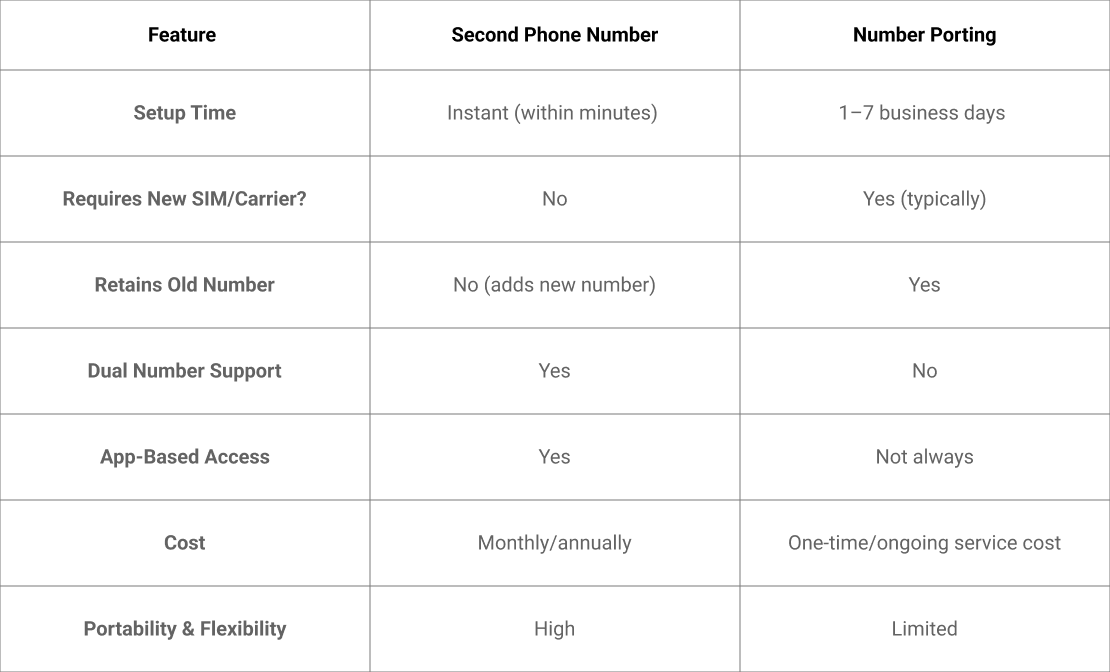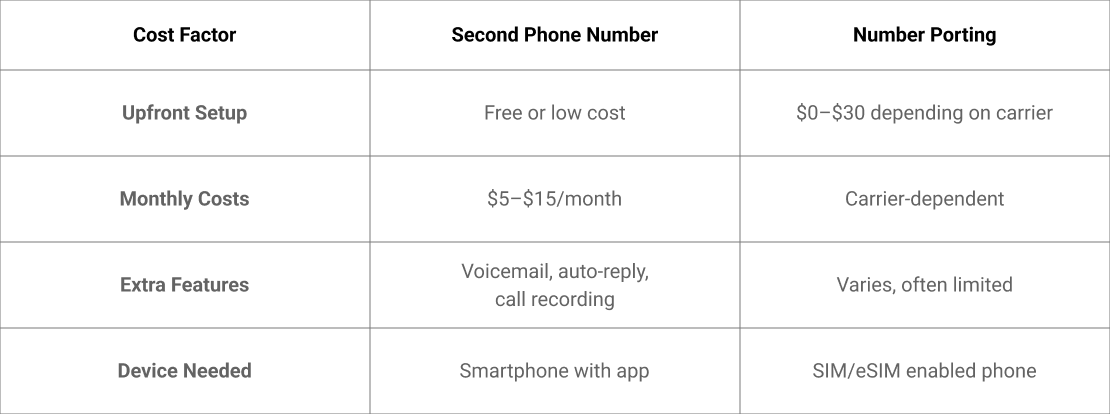
In today’s hyper-connected world, maintaining accessibility both professionally and personally is essential. Whether you’re an entrepreneur, freelancer, digital nomad, or remote worker, how you handle your phone number is more important than ever.
To move carriers, two increasingly popular options are to add a Second Phone Number or go through the phone number porting process. But which one is best for you?
In this article, we’ll go over the differences between Second Phone Number and number porting, as well as the benefits, uses for a second phone line, and potential negatives. By the end, you’ll know which choice best meets your communication needs in 2025.
What Is Number Porting?
Number porting is the process of moving your phone number from one service provider or company to another. That way, you can keep the same number even if you move phone companies, device types (like from SIM to eSIM), or personal to business phone systems.
How the Phone Number Porting Process Works:
- You initiate the request with your new carrier.
- Provide identification and account verification.
- Your new carrier coordinates with your old one to complete the transfer usually within 1–7 business days.
Use Cases for Number Porting:
- Switching mobile carriers without losing your number
- Moving from a traditional SIM to a VoIP or app-based number
- Consolidating business communications under one contact
What Is a Second Phone Number?
A Second Phone Number is a virtual number that works on its own and not with your main mobile number. Most of the time, it’s cloud-based and operates through an app like Second Phone Number. This lets you make and receive calls, send messages, and manage voicemail from your current smartphone.
How It Works:
- Download a Second Phone Number app like Second Phone Number
- Choose a number (local, toll-free, or international)
- Start using your line instantly no carrier switching required
Use Cases for a Second Phone Line:
- Temporary number for business projects or freelance gigs
- Separate business and personal communications
- International travel and remote work setups
- Dating, classified ads, or online sales where privacy matters
Second Phone Number vs. Number Porting: Key Differences at a Glance

Which Option Is Best for You? Use Case-Based Guide
1. If You’re a Freelancer or Entrepreneur
Need to separate work from personal life? A Second Phone Number is ideal.
Best Choice: Second Phone Number
- Enables clear business identity
- Ideal temporary number for business projects
- Advanced features like auto-responders and voicemail
2. If You’re Switching Carriers but Want to Keep Your Number
Going through the phone number porting process makes sense here.
Best Choice: Number Porting
- Retain your number without disruption
- Stay accessible to all existing contacts
- Be sure to settle all dues with your current provider beforehand
3. If You Travel Often or Work Remotely
Using a Second Phone Number give you cost-effective communication without roaming.
Best Choice: Second Phone Number
- Local/international numbers via app
- Works over Wi-Fi or mobile data
- Easy to pause when not in use
4. If You’re Rebranding or Restructuring Your Business
You may want to add a temporary number for business use while transitioning.
Best Choice: Second Phone Number
- Use a new number for your new brand
- Continue using your old number during the shift
- Flexibly phase out the old line
5. If You’re Downsizing Devices or Carrier Plans
Want to retain your number on a new setup? Consider porting vs virtual number solutions.
Best Choice: Number Porting
- Transfer to a new provider or device
- Eliminate the need for a second handset
- Useful when consolidating communication channels
Pros and Cons Breakdown
Advantages of a Second Phone Number
- Instant setup with no carrier hassle
- Ideal for use cases like consulting, gig work, or dating
- Protects your personal number
- Supports multiple numbers on one device
- No need to change your main SIM or carrier
Disadvantages
- Doesn’t retain your old number
- Requires a stable internet connection
- Monthly or annual fees may apply
Advantages of Number Porting
- Seamless transition while retaining identity
- Great for long-term continuity
- No need to inform contacts about a new number
Disadvantages
- Slower setup time
- Some carriers charge fees
- Vulnerable to security risks like SIM-swapping
- Not ideal if you’re testing or need a short-term number
Need help navigating this process? Contact our support team for expert assistance.
Cost Comparison: Second Phone Number vs. Number Porting

Verdict: For flexibility, privacy, and lower setup barriers, Second Phone Numbers often win especially in short-term or business-use scenarios.
Security and Privacy Considerations
Second Phone Number
- Great for privacy protection (e.g., online listings or dating)
- Number masking ensures personal info is never exposed
Number Porting
- Secure your account during the phone number porting process
- Use two-factor authentication and carrier PINs
- Be wary of SIM swap fraud during transitions
Final Decision Framework
Ask yourself:
- Need to keep your current number? → Go with number porting
- Need a temporary number for business or privacy? → Use a Second Phone Number
- Want to save money and gain flexibility? → Second Phone Number
- Is it a one-time switch or an ongoing need? → One-time: porting, ongoing: Second Phone Number
Why Second Phone Number Is the Smart Choice in 2025
Second Phone Number gives you all the tools you need to stay linked and in charge, whether you run a small business, work as a consultant, or travel a lot.
Key Benefits:
- Quick 3-step setup
- Wide selection of number types
- Smart features like voicemail transcription and call forwarding
- Affordable pricing for growing teams and solopreneurs alike
Get your Second Phone Number today and unlock flexible, modern communication.
Conclusion:
It all depends on what you want to do when you choose between porting and a virtual number.
If you want to keep your current number when you switch providers, porting is an excellent option.
On the other hand, a Second Phone Number is the ideal solution for privacy, versatility, and how quickly it can be set up. This is especially true for workers today who want things to be easy to use and control.
In 2025, communication is smarter, faster, and more adaptable. Make sure your phone number strategy reflects that.
Ready to make the smart switch? Try Second Phone Number today and upgrade your communication experience.